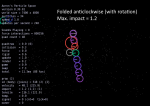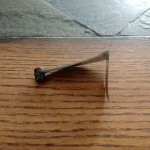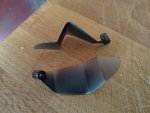BGabor, After going through the bad experience of having one of my props disintegrate on takeoff and then having the anafi crash, if I see a hairline crack or a chip, I am replacing the prop. These props are so thin and lightweight that the stress the spinning motor puts on a hairline crack could cause a failure at the most inopportune time. I often fly above forests and open water; loosing the anafi in either of these type of areas would not be fun. I guess buying extra props as spares is just part of the cost of flying the Anafi - I don't like it, but it is a tradeoff for the quiet aspect of the Anafi, which is important for me.
Welcome to our Community
Wanting to join the rest of our members? Feel free to sign up today.
Sign up
You are using an out of date browser. It may not display this or other websites correctly.
You should upgrade or use an alternative browser.
You should upgrade or use an alternative browser.
Always Check Your Props Before Take Off!
- Thread starter TJBC75
- Start date
AaronB
Well-known member
- Joined
- Dec 4, 2018
- Messages
- 159
- Reaction score
- 136
Being curious as to exactly what happens to the props when the Anafi starts, I decided to set up a simulation using a particle based physics engine. The following (in slow motion) shows engine start with the propeller in one of three positions: fully closed against rotation, fully extended and fully closed with rotation:
The most notable thing is that the propeller will ALWAYS hit the hub of the opposing propeller regardless of the initial start position.
I then tracked the relative forces during collision for each of the start positions:



The interesting thing here is that starting the Anafi with the props fully extended is possibly the worst scenario.
Folding the propellers fully against the direction of rotation seems to be the safest start up position.
The most notable thing is that the propeller will ALWAYS hit the hub of the opposing propeller regardless of the initial start position.
I then tracked the relative forces during collision for each of the start positions:



The interesting thing here is that starting the Anafi with the props fully extended is possibly the worst scenario.
Folding the propellers fully against the direction of rotation seems to be the safest start up position.
Liger 1956
Well-known member
That is very interesting and not what I would have expected. Thanks for doing the research.
I wonder if anybody on the forum has access to a high speed camera to verify that real life is similar to the theory.
I wonder if anybody on the forum has access to a high speed camera to verify that real life is similar to the theory.
Dirk_ANAFI
Well-known member
Very interesting!
I noticed a slower speed of the motors at startup before they reach their liftoff speed.
Theoretically: if I start the motors in a very low speed, then the propellers would touch the other prop's hub once, but with very low impact. Shortly after this they will unfold and stay there for the rest of the flight.
I noticed a slower speed of the motors at startup before they reach their liftoff speed.
Theoretically: if I start the motors in a very low speed, then the propellers would touch the other prop's hub once, but with very low impact. Shortly after this they will unfold and stay there for the rest of the flight.
Thanev
Well-known member
Be real careful the loctite does not come in contact with the prop as it can cause catastrophic failure. I had this happen on another quad I have....twice.I am just removed the first screw. As i started to rotate I felt a little bit more fixing and now I see, there is a blue liquid. I think it is Loctite. I will use the Loctite when I'll put it back. Very small screw and rotating very fast. I am afraid on those props where the rotating direction is the opposite than the screw closing direction so, maybe it can open it without Loctite. (I have a Ducati, there I have to use the Loctite on every screw or else the vibration open it a little bit later).
Jagerbomb52
Well-known member
Be real careful the loctite does not come in contact with the prop as it can cause catastrophic failure. I had this happen on another quad I have....twice.
The locktite does not dissolve the plastic, but will cause it to become extremely brittle and crack easily. This does not happen with all plastics however, I have a feeling polyethylene would be ok with it. In RC Helicopters the rule is that locktite is used for metal to metal, and CA (superglue) is used for metal to plastic connections. I always use one or the other when assembling any model, and clean the threads first with alcohol to remove any oil before assembly.
Thanev
Well-known member
Yes.Keep it off the prop and there shouldn't be any chance of a brittle reaction...The locktite does not dissolve the plastic, but will cause it to become extremely brittle and crack easily. This does not happen with all plastics however, I have a feeling polyethylene would be ok with it. In RC Helicopters the rule is that locktite is used for metal to metal, and CA (superglue) is used for metal to plastic connections. I always use one or the other when assembling any model, and clean the threads first with alcohol to remove any oil before assembly.
BGabor
Well-known member
Ok, I will not use the Loctite and I will start the Anafi with "closed" props. But, what was that original blue thing at the end of every little screws when I changed the props? The factory put something on it.
Jagerbomb52
Well-known member
Here is my take on this. It is OK to use loctite as long as you do not expose the plastic props to it. So all you need is a little drop on each screw and it should be fine to use. This is what they probably used at the factory. Just a guess on my part. I think the point everyone is trying to make is don't use more then what you need to secure the screws. A little drop goes a long way. 
Dirk_ANAFI
Well-known member
Yes, that seems to be a threadlockable paint, so not a glue, but a kind of varnish.Ok, I will not use the Loctite and I will start the Anafi with "closed" props. But, what was that original blue thing at the end of every little screws when I changed the props? The factory put something on it.
tx_pilot
Member
- Joined
- Jan 25, 2019
- Messages
- 14
- Reaction score
- 3
The blue thread lock on the stock screws is not the same chemical as liquid blue Locktite. It will destroy plastic in few months.
If you want to put something on the threads I'd use a dab of silicone rubber glue.
So what specifically is the blue thread lock on the stock screws that they are using from factory?
RemE
Well-known member
- Joined
- Nov 27, 2018
- Messages
- 62
- Reaction score
- 32
It's not Loctite, as it is dry and bright blue, something Loctite would not be if applied and left to dry. It's some form of polymer that gums up the threads when assembled. That's why I use silicone rubber glue on threads around plastic, has always worked well for me.So what specifically is the blue thread lock on the stock screws that they are using from factory?
justDee
Well-known member
In regards to replacing the props, is the consensus that you only use Parrot OEM blades? A lot more aftermarket blades on the internet. I haven't bought any yet, but from the sounds of it, I need to have some spares.
And awesome job on the simulation. Way above my paygrade stuff.
And awesome job on the simulation. Way above my paygrade stuff.
Thanev
Well-known member
I was referred to these props by Parrot(!).Yes.By Parrot.
At this price I replace them with the slightest nick.
Keep in mind they don't come with screws.I bought a set from Parrot as well to get extra screws.Very expensive screw...
Amazon.com: Anbee 16pcs Propeller Props Blades for Parrot Anafi - 4K HDR Camera Drone (Black, 16pcs) : Toys & Games
Buy Anbee 16pcs Propeller Props Blades for Parrot Anafi - 4K HDR Camera Drone (Black, 16pcs): Propellers - Amazon.com ✓ FREE DELIVERY possible on eligible purchases
www.amazon.com
Keep in mind they don't come with screws.I bought a set from Parrot as well to get extra screws.Very expensive screw...
justDee
Well-known member
Jagerbomb52
Well-known member
Looking at another post from one of our members trying to bend and or break the prop and could not I decided to take one of my older damaged props and try and break it. There was no way I could fold it over and have it break at the fold. I had a prop break and come off at where it gets screwed on so I now think that is the weakest link on our props. Chips and crack only seem to go up to where the thicker part of the prop starts. Not saying do not change them if you see a chip or crack but I do not think it will cause a problem if you do not catch it right away.


AaronB
Well-known member
- Joined
- Dec 4, 2018
- Messages
- 159
- Reaction score
- 136
A single fold is not an indicator of durability, most cheap plastics will not break on a single fold. A better test is how often can you bend the prop backwards and forwards before it separates - this would be more representative of the stress the props can undergo from constant vibration. A nick in the side of the prop could develop very quickly (like a crack in a windscreen) to full separation when up and flying.Looking at another post from one of our members trying to bend and or break the prop and could not I decided to take one of my older damaged props and try and break it. There was no way I could fold it over and have it break at the fold.
Hello,
a little suggestion which maybe could help to reduce the problem with broken props. I wrapped a fitting (very small) piece of "Tesa" (or some similar Tape with the same thickness) around the bolts to reduce the clearance. Now the props are not so loose on the bolts. Before the takeoff I have to unfold the props. I have perceptible less vibration on the arms of Anafi. The vibration on the loose original propellers could also be a reason for the cracks (I never had after nearly 100 Flights). In my opinion the dent from the bump of opposite bolt is not the main cause. I don't use any Loctite ore something to lock the bolts.
I have seen that the case from Anafi extendet can also squeeze the propellers - if they are not wobbling at the bolt the chance for squeezing during transportation is reduced also if I place them in the right way.
Maybe it's a little try and error to find the right balance between loose and too strong - the props should align even with start from hand. For me one layer of "Tesa" around the bolt was the right thickness.
One final word to the Case of Anafi extended - in my opinion a magnet shouldn't be so close to the Anafi. I removed it and use velcro.
Greetings from Germany
a little suggestion which maybe could help to reduce the problem with broken props. I wrapped a fitting (very small) piece of "Tesa" (or some similar Tape with the same thickness) around the bolts to reduce the clearance. Now the props are not so loose on the bolts. Before the takeoff I have to unfold the props. I have perceptible less vibration on the arms of Anafi. The vibration on the loose original propellers could also be a reason for the cracks (I never had after nearly 100 Flights). In my opinion the dent from the bump of opposite bolt is not the main cause. I don't use any Loctite ore something to lock the bolts.
I have seen that the case from Anafi extendet can also squeeze the propellers - if they are not wobbling at the bolt the chance for squeezing during transportation is reduced also if I place them in the right way.
Maybe it's a little try and error to find the right balance between loose and too strong - the props should align even with start from hand. For me one layer of "Tesa" around the bolt was the right thickness.
One final word to the Case of Anafi extended - in my opinion a magnet shouldn't be so close to the Anafi. I removed it and use velcro.
Greetings from Germany
Similar threads
- Replies
- 4
- Views
- 410



